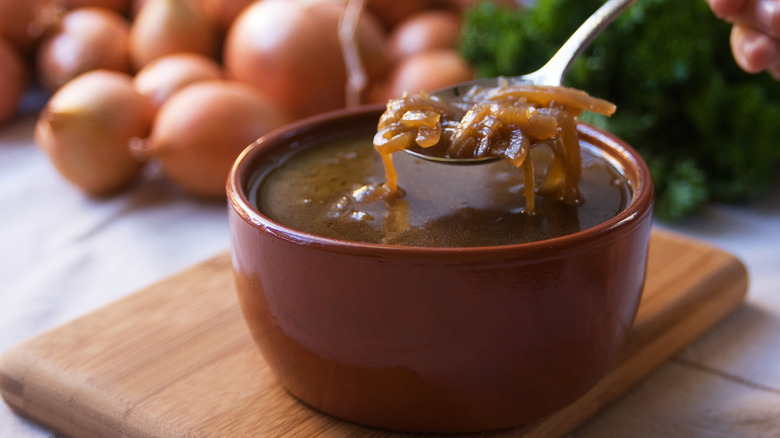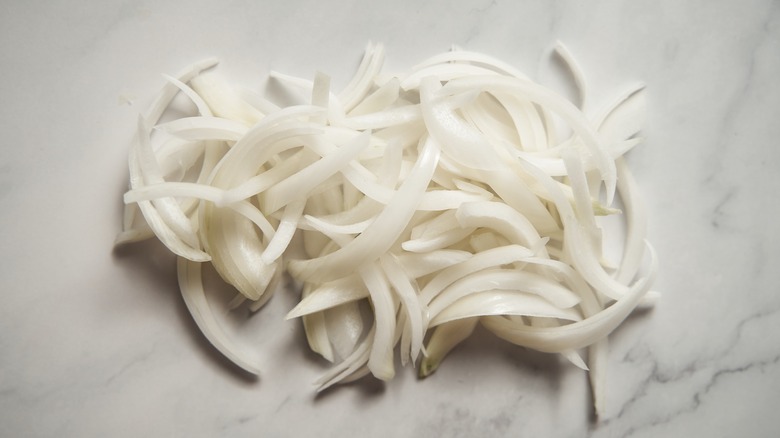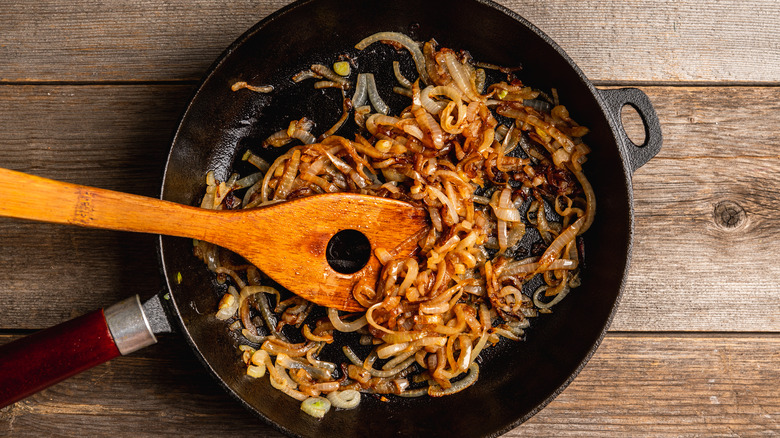The Onion Mistakes Keeping You From Perfect French Onion Soup
On paper, french onion soup seems like a simple recipe: It typically has just a handful of ingredients (some of which are pantry staples like salt and butter), and cheesy bread aside, it requires just one pot to prepare. But for all its apparent simplicity, there's still ample room to go wrong, and a lot of it comes down to what you do with the onions in the recipe.
Firstly, you need to start out with the right onions for the job. There's not a "wrong" type of onion to use, and some cooks even recommend using a mix, but there are a few factors to consider. Red onions may add a less-appetizing color to the soup, and sweet onions may end up making the soup less nuanced in flavor, with an overriding sweetness. If you want to keep things classic, go for yellow onions. French chef Raymond Blanc has highlighted Pink Roscoff onions as a particular type (despite the name, they're not a red onion), but since these may be hard to source, yellow onions are probably your best bet. And naturally, fresher onions are better than those on the edge of going off.
The wrong and right way to prepare your onions
You probably want the onions to be palpable within the broth; for this reason, most recipes recommend slicing them, so you get actual pieces in the soup, rather than a fine dice. If they're chopped too small, they won't have any texture. To prep those onions, you'll want to lop off the ends of them and remove the skin, as with almost any other recipe. But while it might be tempting to slice them parallel to the rings of the onion (this could be called "east to west"), it may be better to slice them from pole to pole, or north to south. This is how Julia Child did it, and helps keep the onion slices more intact as they cook.
French chef Ludo Lefebvre even suggests ditching the centers of the onions, as they can be bitter (although this may depend on personal preference). Lastly, before any onion hits the pan, make sure all the slices are separated out so that you'll be able to caramelize them evenly.
Don't rush the caramelization process
Even with perfectly chosen and chopped onions, you'll need to get the cooking right for a dreamy french onion soup. Classic recipes call for your onions to be caramelized, and it's this step where cooks often go wrong, even though it really just involves slow-cooking your onions in butter, perhaps with salt and pepper.
There's two big mistakes here (although they're arguably linked together): Not allowing your onions enough time to caramelize, and not caramelizing your onions on a low enough heat. For the former, the exact length of time varies, but it's often recommended that you caramelize your onions for at least an hour, and potentially even two or three. Cooks might try to turn the heat up for a faster caramelization, but this can just result in burned onions; pretty much every pro recommends sticking to low heat.
There are good ways to speed up the caramelization process: For example, Ina Garten recommends using a bigger pot so that more onions are exposed to heat at any one time. But you should still beware of rushing it too much: One Garten recipe recommends 20 minutes of caramelization, but in reality, chances are you'll need at least 45 minutes and potentially more. Otherwise, you're just sacrificing flavor. From here, your other ingredients like stock and wine will go in, and if you've caramelized the onions right, you'll have a rich, deeply-flavored soup.


